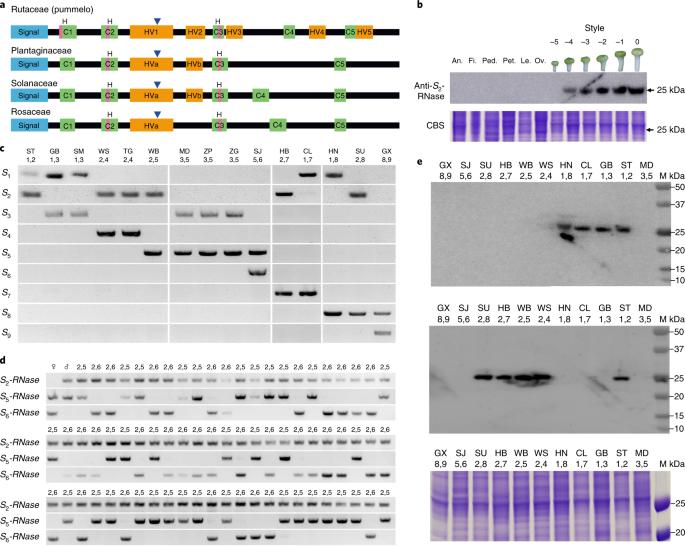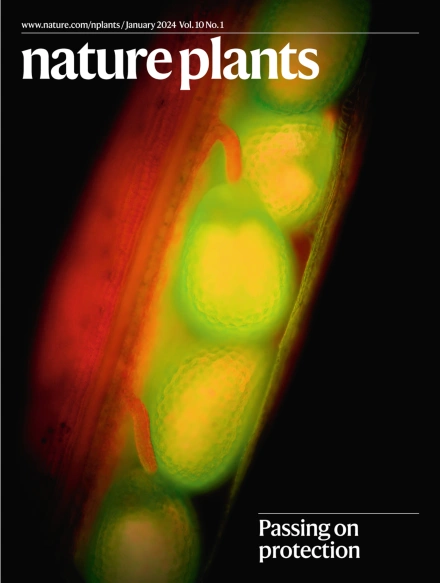Evolution of self-compatibility by a mutant Sm-RNase in citrus
IF 13.6
1区 生物学
Q1 PLANT SCIENCES
引用次数: 62
Abstract
Self-incompatibility (SI) is an important mechanism that prevents self-fertilization and inbreeding in flowering plants. The most widespread SI system utilizes S ribonucleases (S-RNases) and S-locus F-boxes (SLFs) as S determinants. In citrus, SI is ancestral, and Citrus maxima (pummelo) is self-incompatible, while Citrus reticulata (mandarin) and its hybrids are self-compatible (SC). Here, we identify nine highly polymorphic pistil-specific, developmentally expressed S-RNases from pummelo that segregate with S haplotypes in a gametophytic manner and cluster with authentic S-RNases. We provide evidence that these S-RNases function as the female S determinants in citrus. Moreover, we show that each S-RNase is linked to approximately nine SLFs. In an analysis of 117 citrus SLF and SFL-like (SLFL) genes, we reveal that they cluster into 12 types and that the S-RNases and intra-haplotypic SLF and SLFL genes co-evolved. Our data support the notion that citrus have a S locus comprising a S-RNase and several SLFs that fit the non-self-recognition model. We identify a predominant single nucleotide mutation, Sm-RNase, in SC citrus, which provides a ‘natural’ loss of function. We show that SI–SC transitions due to the Sm-RNase initially arose in mandarin, spreading to its hybrids and became fixed. Identification of an evolutionarily distant new genus utilizing the S-RNase-based SI system, >100 million years separated from the nearest S-RNase family, is a milestone for evolutionary comparative studies. Self-incompatibility prevents inbreeding in flowering plants. In the genus Citrus, there are both self-incompatible and self-compatible species. Now, the molecular mechanism and evolutionary perspectives are revealed to explain the heterogeneity of self-recognition in citrus.

柑橘中突变体 Sm-RNase 的自我相容性进化
自交不亲和性(SI)是防止开花植物自交和近交的重要机制。最普遍的 SI 系统利用 S 核糖核酸酶(S-RNases)和 S-焦点 F-框(SLFs)作为 S 决定因子。在柑橘中,SI 是祖先遗传的,Citrus maxima(柚子)是自交不亲和的,而 Citrus reticulata(柑橘)及其杂交种是自交不亲和(SC)的。在这里,我们从柚子中鉴定出九种高度多态的雌蕊特异性、发育表达的 S-RNases ,这些 S-RNases 以配子体的方式与 S 单倍型分离,并与真实的 S-RNases 聚类。我们提供的证据表明,这些 S-RNases 在柑橘中起着雌性 S 决定因子的作用。此外,我们还发现每个 S-RNase 都与大约九个 SLF 相关联。在对 117 个柑橘 SLF 和类 SLFL(SLFL)基因的分析中,我们发现这些基因聚类为 12 个类型,而且 S-RNases 与单倍型内的 SLF 和 SLFL 基因共同进化。我们的数据支持柑橘有一个 S 基因座的观点,该基因座由一个 S-RNase 和几个 SLF 组成,符合非自我识别模式。我们发现柑橘SC基因中存在一个主要的单核苷酸突变--Sm-RNase,它提供了一种 "自然 "的功能缺失。我们的研究表明,Sm-RNase导致的SI-SC转变最初出现在柑橘中,后来扩散到其杂交种中并固定下来。利用基于S-RNase的SI系统鉴定出一个进化遥远的新属,与最近的S-RNase家族相隔1亿年,这是进化比较研究的一个里程碑。自交不亲和防止了有花植物的近亲繁殖。在柑橘属中,既有自交不亲和的物种,也有自交不亲和的物种。现在,我们从分子机制和进化角度揭示了柑橘自相容性的异质性。
本文章由计算机程序翻译,如有差异,请以英文原文为准。
求助全文
约1分钟内获得全文
求助全文
来源期刊

Nature Plants
PLANT SCIENCES-
CiteScore
25.30
自引率
2.20%
发文量
196
期刊介绍:
Nature Plants is an online-only, monthly journal publishing the best research on plants — from their evolution, development, metabolism and environmental interactions to their societal significance.
 求助内容:
求助内容: 应助结果提醒方式:
应助结果提醒方式:


